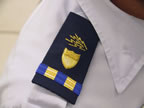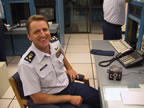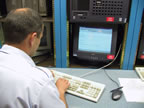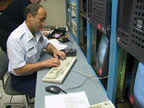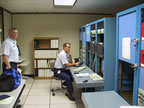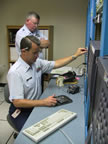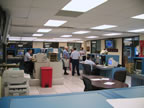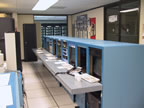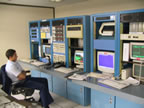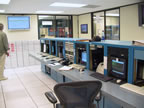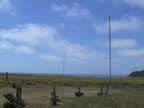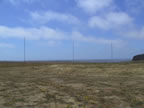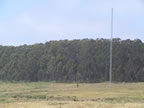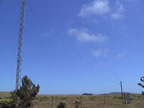USCG
CAMSPAC
|
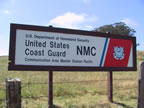 |
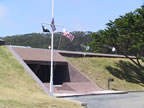 |
|
CAMSPAC = Communications Area Master Station Pacific Click on any image on this page for full-size photo. Complete photo album |
Sign at the entrance to NMC at 17000 Sir Francis Drake Blvd. in Point Reyes National Seashore | The entrance to the CAMSPAC station building. |
On July 1st, 2003 a special event was held at the Coast Guard radio station NMC located at Point Reyes, CA (in West Marin County). This is the reception and control site. The transmitting site is at 482 Mesa Rd., Bolinas, CA
This station is one of two master stations that handle all long-distance radio communications for the Coast Guard. (This station serves the Pacific hemisphere, the other serves the Atlantic hemisphere.)
The event was the retiring of a specialty or rating that designates a US Coast Guard man as a qualified radioman. The rating was commonly known as "Sparks".
In the past one unique skill of a radioman was mastery of Morse code. For this special event, messages were sent and received using Morse code (CW). The use of Morse code by the Coast Guard was previously discontinued on August 16th, 1994.
The first Coast Guard communicators were known as Radiomen but earned the nickname Sparks because of the electrical nature of early wireless equipment. "Sparks" also became the term to describe the lightning bolts that became the emblem of the Radioman rating designator. In 1994, the Coast Guard changed the name of the Radioman rating to "Telecommunications Specialist", in order to better reflect the job being performed by the communicators operating in the digital era. Although the rate had undergone a significant change, the traditional sparks remained the symbol of the Coast Guard Communicator for another decade.
Today Coast Guard Communicators face a new change, as the Telecommunications Specialist rating becomes incorporated into two new ratings, Information System Technician and Operations Specialist. Along with the passing of the TC rating, we are also witnessing the retirement of the long held insignia for the Coast Guard Communicator - the "sparks" rating designator.
At Noon a commemorative message was transmitted using CW on two frequencies:
448Khz and 8574Khz. Here's the message that was
sent.(PDF format) The actual transmitters and transmitting antennas
for NMC are remotely located in Bolinas, CA. The receivers and receiving
antennas are at the CAMSPAC site in Point Reyes where these photos were
taken.
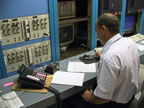 |
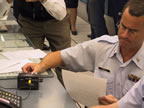 |
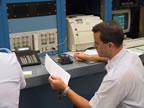 |
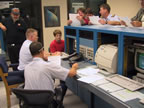 |
|
Loren R. O'Banion, |
Senior Chief Petty Officer (SCPO) Heckler, CAMSPAC sending CW message | Hecklerr sending CW message | Heckler sending and on-lookers |
After the commemorative message was sent, messages were exchanged by several current and former marine commercial stations using morse code. Stations included: KPH, KLB, and WLO
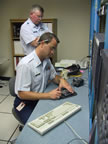 |
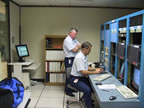 |
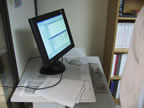 |
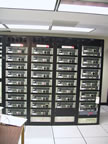 |
|
Bill Heckler receiving and on-looker |
This operating station is normally used to remotely control CAMSLANT stations. The screen on the left is a PC that controls the receivers. | Here's a close up of the receiver control screen. This is a Windows program that is running on several PCs throughout the station to control the receivers over a LAN. | This is a rack of recievers that are computer controlled via the LAN |
Antennas
There are a number of antennas at Point Reyes. These include microwave, satellite, and HF antennae.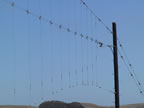 |
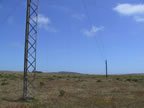 |
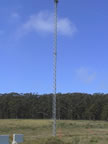 |
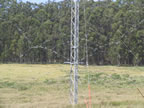 |
|
Close-up of antenna 5 |
Antenna 5 more detail | Antenna 7 is an omni- directional antenna. Note the birds nest at the top. | Closeupof antenna 7 note the intricate web of wires. |
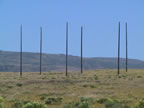 |
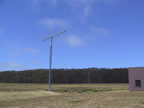 |
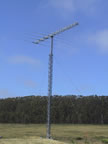 |
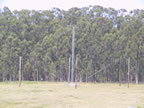 |
|
Antennas 8 is an omni-directional inverted cone. |
Antennas 9 is a rotatable horizontally polarized log periodic | Antenna 9 | Antenna 10 is an omni-directional inverted cone. |
Click on any image to see full-size photo.
